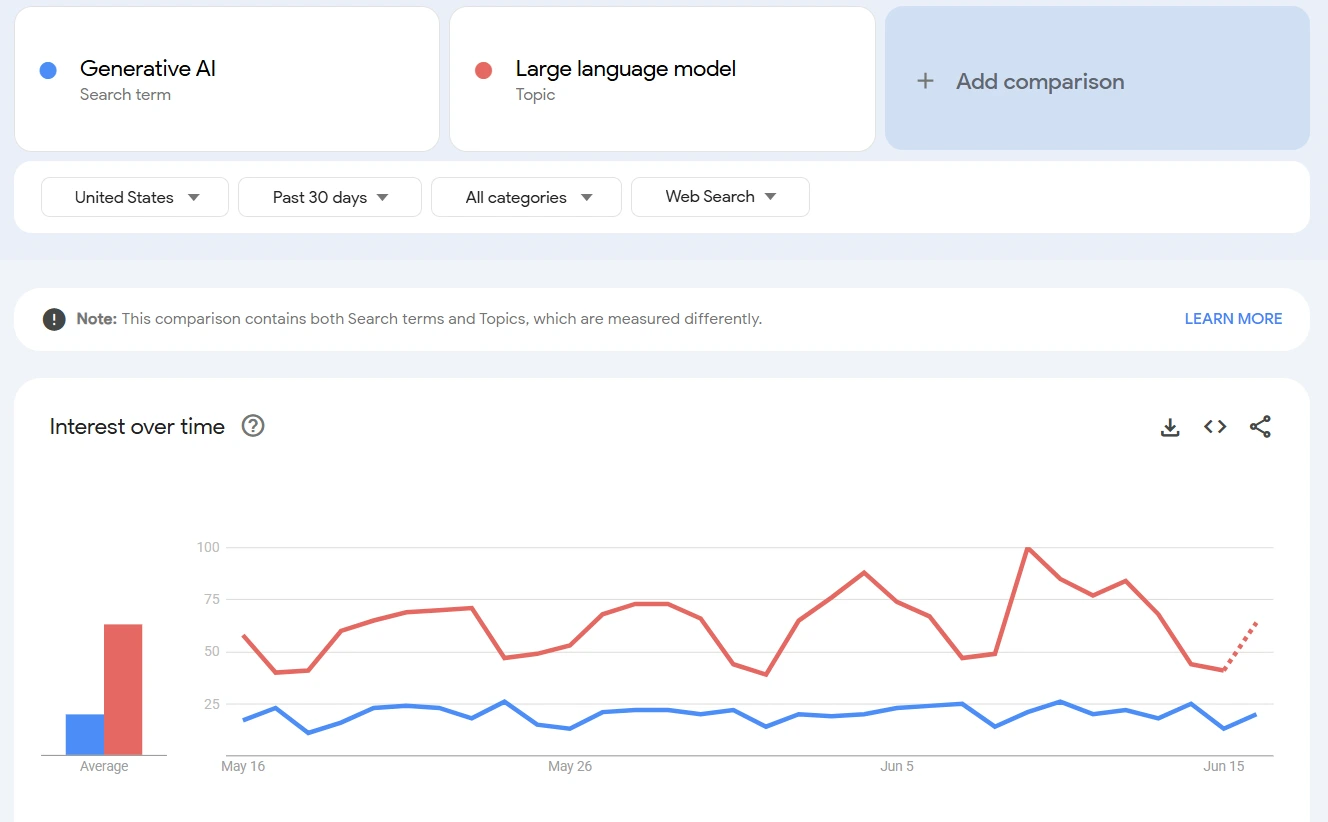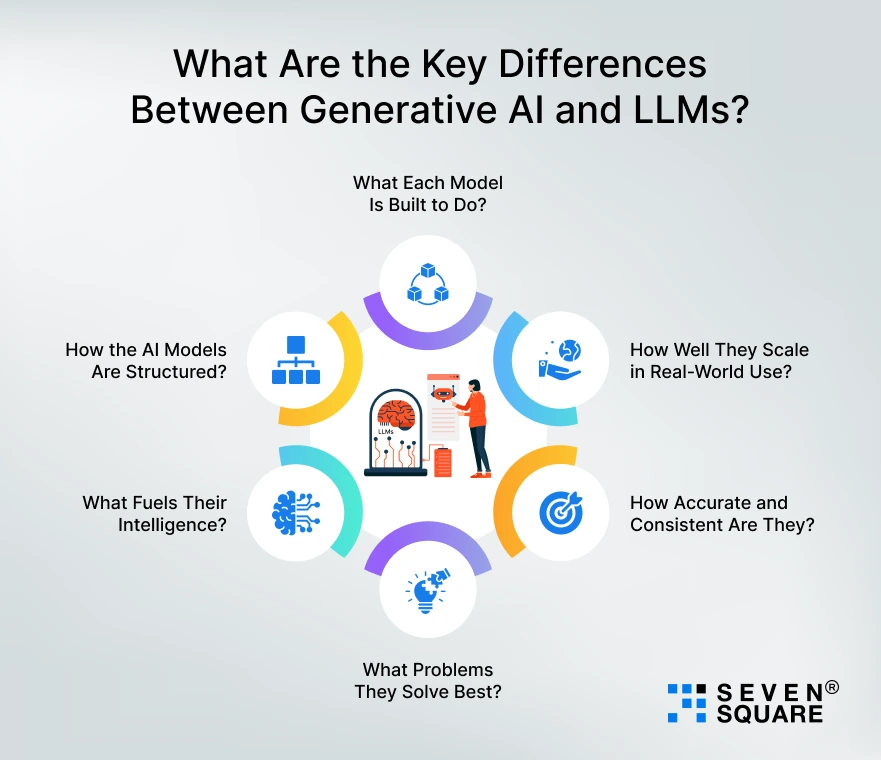Imagine you’re building the next big AI-powered product.
You’ve secured funding, assembled a lean team, and mapped out your vision.
But as soon as you dive into the technical blueprint, one question keeps coming back: “Should we build on a Large Language Model (LLM) or use Generative AI?”
This decision isn’t just academic.
It’s about time-to-market, budget, scalability, and user experience.
Getting it wrong could mean months of rework or worse to launch with tech that doesn’t meet your goals.
At Seven Square, we’ve delivered custom AI solutions across industries from logistics and finance to education and retail.
In this blog, we tried to break down LLM vs Generative AI in detail with real-world use cases and insights.
All your doubts regarding Large Language Model vs Generative AI.
What is a Large Language Model (LLM)?
A Large Language Model is an advanced type of AI trained on massive text datasets to understand and generate human-like language.
Think GPT-4, or Claude. These models excel at:
- Summarizing content
- Writing code
- Translating languages
- Powering chatbots and virtual assistants
They are designed for text-based generation and comprehension and use deep learning and attention mechanisms to predict the next word in a sentence.
Learn about the top 10 LLM Models.
What is Generative AI?
Generative AI is a broader term.
It includes any AI model that can create new content, not just text, but also images, audio, videos, and even code.
LLMs are a subset of Generative AI, which also includes:
- Image generation models like DALL-E and Midjourney
- Music composition AIs
- Video synthesis tools
In short, Generative AI is the umbrella. LLMs are one powerful tool under it.
Generative AI vs LLM: A Side-by-Side Comparison

Source: Google Trends
Understanding the key differences between Generative AI and LLMs is necessary when designing your AI strategy.
Here’s a direct Generative AI vs LLM comparison:
| Feature/Aspect | Large Language Models (LLMs) | Generative AI (Broad Scope) |
|---|---|---|
| Focus | Text understanding & generation. | Multi-modal content generation. |
| Examples | GPT-4, & Claude. | DALL-E, Midjourney, Runway, & Codex. |
| Primary Use Cases | Chatbots, summarization, code, & search. | Image, video, audio, 3D, and text content. |
| Data Type | Text | Text, images, audio, video, & code. |
| Input | Mostly text prompts | Text, image, audio, & video prompts. |
| Output | Text | Multi-modal outputs |
| Model Size | Often billions of parameters. | Varies widely depending on modality. |
| Training Data | Internet-scale text. | Diverse datasets: images, audio, & code. |
| Best For | Language-based AI apps. | Creative, multimedia, or hybrid AI apps. |
| Limitations | Struggles witd non-text modalities. | May lack precision in language tasks. |
| 2025 Trend | Narrowing for vertical-specific LLMs. | Expanding into more creative domains. |
This LLM vs Generative AI comparison makes it easier to assess which model aligns better with your business case, especially when building scalable AI products in 2025.
What Are the Key Differences Between Generative AI and LLMs?

When evaluating AI for your application, it’s essential to understand how Generative AI and Large Language Models (LLMs) differ at their core.
Here’s a breakdown of the main dimensions where they diverge:
1. What Each Model Is Built to Do?
- LLMs are designed specifically for language-based tasks. Their strength lies in text generation, comprehension, summarization, and code assistance.
- Generative AI, on the other hand, is a broad category that creates all kinds of content like images, music, video, 3D models, and text. It covers much more than just language.
2. How the AI Models Are Structured?
- LLMs use transformer-based architectures optimized for text processing. Their design prioritizes understanding syntax, semantics, and context in human language.
- Generative AI models vary widely in architecture. For example, image models like GANs and diffusion models are structurally different from LLMs and optimized for visual data.
3. What Fuels Their Intelligence?
- LLMs are trained on massive text like books, websites, code, & articles to deeply understand language patterns.
- Generative AI models use diverse data: images (ImageNet, LAION), audio (LibriSpeech), video datasets, and more. This multi-modal training allows them to generate different types of media.
4. What Problems They Solve Best?
- LLMs excel at structured tasks like document summarization, translation, Q&A, conversational AI, and code generation.
- Generative AI solves creative or visual problems like image creation, style transfer, music generation, and video editing. It’s used where expression and media synthesis are key.
5. How Accurate and Consistent Are They?
- LLMs are generally more reliable for deterministic language tasks and fine-tuned outputs, especially in enterprise and knowledge-based applications.
- Generative AI may produce more variable results due to creative randomness. It excels in ideation and visuals but may lack consistency in structured output.
6. How Well They Scale in Real-World Use?
- LLMs are becoming highly optimized for performance, with smaller fine-tuned models and API accessibility (e.g., OpenAI, Anthropic).
- Generative AI models require more GPU/TPU-intensive processing, especially for video or image generation, but are rapidly advancing with tools like Runway and Pika.
Understanding these differences can guide your product roadmap, helping you decide whether to deploy LLMs, Generative AI, or a hybrid approach.
Large Language Models vs Generative AI: When To Choose What?
Choosing between Generative AI vs LLMs depends on your application’s end goals:
Use Large Language Models when your product revolves around:
- Text summarization
- Question answering
- Coding assistants
- Chatbots or virtual agents
- Document understanding or classification
Choose Generative AI when you need to:
- Generate product images or creative visuals
- Build interactive videos or animations
- Create audio responses or synthetic voices
- Design marketing visuals or creative campaigns
Rule of thumb for 2025:
- For structured outputs and language-heavy logic, go LLM.
- For visual, creative, or sensory-rich applications, go
Your AI model strategy can shape user experience, development cycles, and product-market fit. Evaluate based on modality, UX expectations, and integration complexity.
Why Should You Combine Generative AI With LLMs?

The smartest AI-powered products in 2025 don’t just choose between LLM or Generative AI, they combine them.
Here’s why blending the two is a winning formula:
- Context meets Creativity: LLMs handle intent detection, summaries, & structure. Generative AI transforms that into dynamic output (videos, images, audio).
- Multimodal User Experience: Users expect conversational interfaces that also show them something. LLMs + Gen AI makes that possible.
- Scalable AI Systems: Using LLMs for language and Gen AI for visuals lets you scale modularly without reinventing every layer.
- Better Automation: Think AI agents that can talk, show, explain, and adapt, all in one flow.
Real-World Example: At Seven Square, we built an AI sales assistant for a SaaS platform. It used:
- An LLM to understand the user’s question
- A generative charting tool to build real-time graphs
- A voice model to explain the result verbally
LLM vs Gen AI: Which One Should You Choose?
This depends entirely on your product goals.
- Building a chatbot, document summarizer, or AI writing assistant? Go for a Large Language Model.
- Want to generate product images, marketing videos, or design prototypes with AI? Generative AI is your answer.
But here’s where it gets real: many smart teams are now blending both.
We’ve helped clients build systems that use LLMs for understanding user intent and Generative AI for producing multi-modal content at scale.
LLM vs Gen AI Differences in Real Products
1. LLM Use Case (Client: Fintech SaaS):
- We built a custom assistant using an LLM to help analysts summarize market reports and legal documents.
- The result? 30% faster decision-making and more confidence in their daily workflows.
2. Generative AI Use Case (Client: E-commerce):
- We helped automate their product photography pipeline.
- Now, they generate product lifestyle shots from text inputs. No photoshoots. Just smart image models.
3. Blended Use Case (Client: EdTech):
- This client wanted AI-generated quizzes from YouTube lectures.
- Our solution used an LLM to extract key concepts and a generative video tool to create short animated explainers.
- That’s where LLM vs Gen AI isn’t an “either/or.”
Want to integrate Gen AI or LLM? Contact Us Now!
Generative AI vs LLM: Which Is Better for Text Generation?
In 2025, LLMs still lead in text generation.
Their architecture is optimized for language, context retention, and prompt engineering.
However, Gen AI tools like Gemini or Jasper (which blend LLMs with UI/UX tools) are closing the gap.
If you’re looking for depth, context, and semantic accuracy, choose LLMs.
For style-rich or creative writing, some Generative AI platforms offer better UI/UX, but under the hood, it’s still an LLM doing the work.
What Are the Key Takeaways from LLM vs Generative AI Comparison?
If your AI product lives in a language-first world, start with LLMs.
But if your vision touches visuals, sound, or dynamic storytelling, think broader with Generative AI.
Remember:
- LLM: Best for structured conversation, writing, summarizing, and analysis.
- Gen AI: Best for creation beyond text (images, music, motion, etc.).
- Together: You build what today users expect from smart apps.
FAQs
- LLMs (Large Language Models) specialize in processing and generating human-like text, while Generative AI refers to the broader family of AI systems that can generate content across modalities like text, image, video, and audio.
- LLMs are a subset of Generative AI.
- ChatGPT is both.
- It’s an LLM built on the GPT architecture, which is a specific type of Generative AI model trained to handle text-based tasks.
- Use Generative AI when your project involves visuals, music, videos, or multi-modal outputs.
- If your use case is language-intensive like summarizing, translating, or answering queries because LLMs are the better fit.
- LLMs are more scalable for lightweight, API-based tasks.
- Generative AI often requires higher compute resources, especially for real-time image or video generation, though tools like RunwayML and Pika are making this easier.